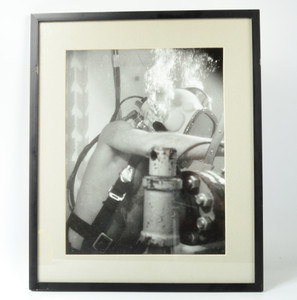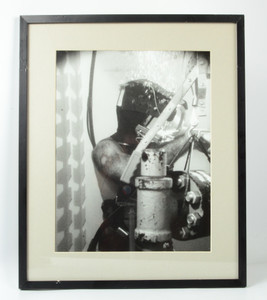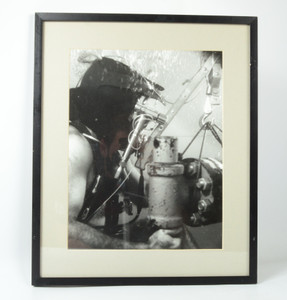Vintage Diver Underwater Work Performance Predictive Study Framed 10x13 Photograph. Dangerous Studies on Human Subjects.
This a framed and matted photograph frame taken during a series of predictive studies conducted in collaboration with NASA, The University of Pennsylvania, U.S. Navy Medical R&D, ONR and The National Institutes of Health, Industry (offshore oil, gas, diving). The photo reference is printed on a sticker affixed to the glass.
The purpose of the Predictive Studies Series was to correlate physiologic responses to extreme environmental stresses.
This item is a photo from Predictive Studies IV (1975) Underwater work performance
Saturation - excursion series in phases of 0, 400, 800, 1200, and 1600 FSW. Exposure to normoxic He.
Physiologic studies and underwater work performance on oil wellhead.
Some information on this study:
Predictive Studies IV was designed to investigate the physiological effects of staged rapid compressions in saturation-excursion diving on normoxic helium-oxygen to simulated depths of 400, 800, 1200, and 1600 fsw (32). There were two separate phases of investigation with four
professional diver-subjects in each phase. Two divers participated in both phases. Phase One consisted of rapid compression to 800 fsw, a two-hour hold at that pressure, and subsequent rapid excursions to 1200 fsw while using 800 fsw as a saturation depth. Subjects were studied in pairs during the initial compression and successive excursions (Figures 4,5). Phase Two involved initial compression to 1200 fsw even more rapidly than before, a 22-hour hold at 1200 fsw, followed by repeated rapid and brief excursions to 1600 fsw with a return to
saturation at 1200 fsw. "
The text describing this photo in the study follows:
"Underwater Work Performance: The underwater work task consisted of a programmed sequence that involved the timed dismantling and reassembly of large valve flange and other oil wellhead components in the water-filled chamber compartment (Figure 6). Prior to the initial compression for Phase Two, training for the underwater work was performed at one atmosphere, both in dry conditions and under 10 to 12 feet of water. The average values of pulmonary ventilation and oxygen uptake for all four divers in air at 1.0 ATA were about 60 and 2.0 liters per minute, respectively. After establishing a range for the four best time trials at 10 fsw, each diver performed the timed underwater work sequence at 1210 fsw during saturation exposure, at 1610 fsw on excursion, and at 1360 fsw during a stable phase of saturation-decompression. With the exception of one run by one diver at 1610 fsw, all of the time trials at simulated depths of 1210-1610 fsw were within or below the range for the four best trials at 10 fsw. "
Photograph Size: 10" X 13"
Frame Size: 14 11/16" x 17 3/4"
Condition
------------
Excellent condition. Frame has few dings and wear marks on it. Photo is in great condition with minimal fading.
This a framed and matted photograph frame taken during a series of predictive studies conducted in collaboration with NASA, The University of Pennsylvania, U.S. Navy Medical R&D, ONR and The National Institutes of Health, Industry (offshore oil, gas, diving). The photo reference is printed on a sticker affixed to the glass.
The purpose of the Predictive Studies Series was to correlate physiologic responses to extreme environmental stresses.
This item is a photo from Predictive Studies IV (1975) Underwater work performance
Saturation - excursion series in phases of 0, 400, 800, 1200, and 1600 FSW. Exposure to normoxic He.
Physiologic studies and underwater work performance on oil wellhead.
Some information on this study:
Predictive Studies IV was designed to investigate the physiological effects of staged rapid compressions in saturation-excursion diving on normoxic helium-oxygen to simulated depths of 400, 800, 1200, and 1600 fsw (32). There were two separate phases of investigation with four
professional diver-subjects in each phase. Two divers participated in both phases. Phase One consisted of rapid compression to 800 fsw, a two-hour hold at that pressure, and subsequent rapid excursions to 1200 fsw while using 800 fsw as a saturation depth. Subjects were studied in pairs during the initial compression and successive excursions (Figures 4,5). Phase Two involved initial compression to 1200 fsw even more rapidly than before, a 22-hour hold at 1200 fsw, followed by repeated rapid and brief excursions to 1600 fsw with a return to
saturation at 1200 fsw. "
The text describing this photo in the study follows:
"Underwater Work Performance: The underwater work task consisted of a programmed sequence that involved the timed dismantling and reassembly of large valve flange and other oil wellhead components in the water-filled chamber compartment (Figure 6). Prior to the initial compression for Phase Two, training for the underwater work was performed at one atmosphere, both in dry conditions and under 10 to 12 feet of water. The average values of pulmonary ventilation and oxygen uptake for all four divers in air at 1.0 ATA were about 60 and 2.0 liters per minute, respectively. After establishing a range for the four best time trials at 10 fsw, each diver performed the timed underwater work sequence at 1210 fsw during saturation exposure, at 1610 fsw on excursion, and at 1360 fsw during a stable phase of saturation-decompression. With the exception of one run by one diver at 1610 fsw, all of the time trials at simulated depths of 1210-1610 fsw were within or below the range for the four best trials at 10 fsw. "
Photograph Size: 10" X 13"
Frame Size: 14 11/16" x 17 3/4"
Condition
------------
Excellent condition. Frame has few dings and wear marks on it. Photo is in great condition with minimal fading.










